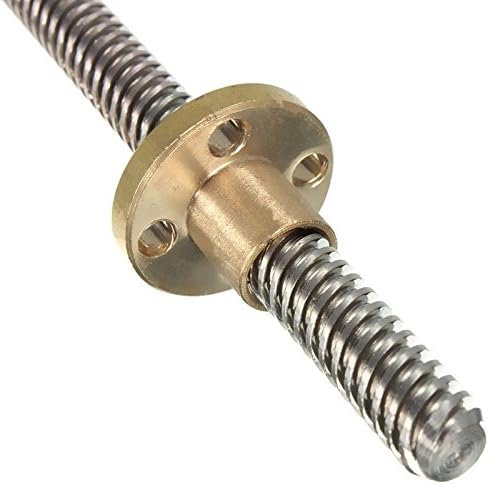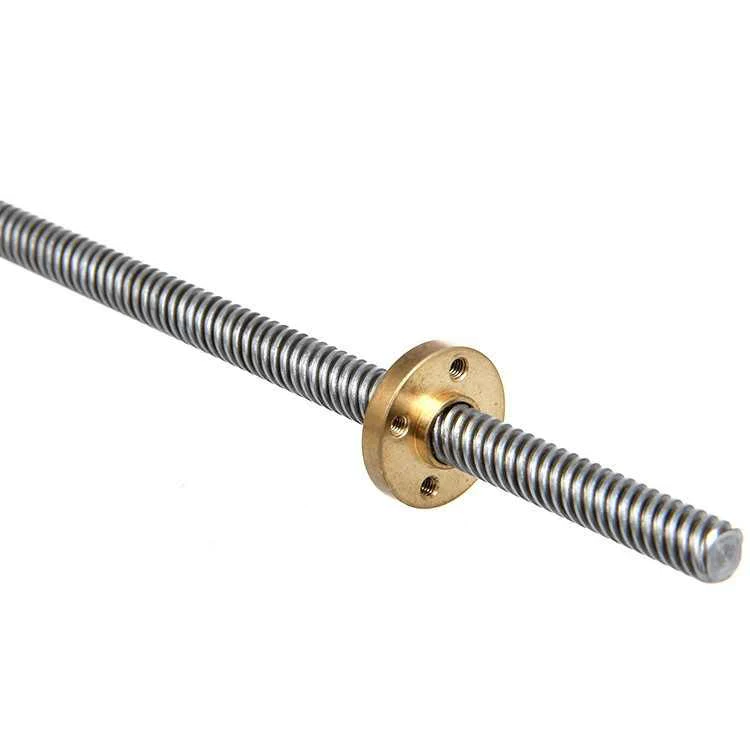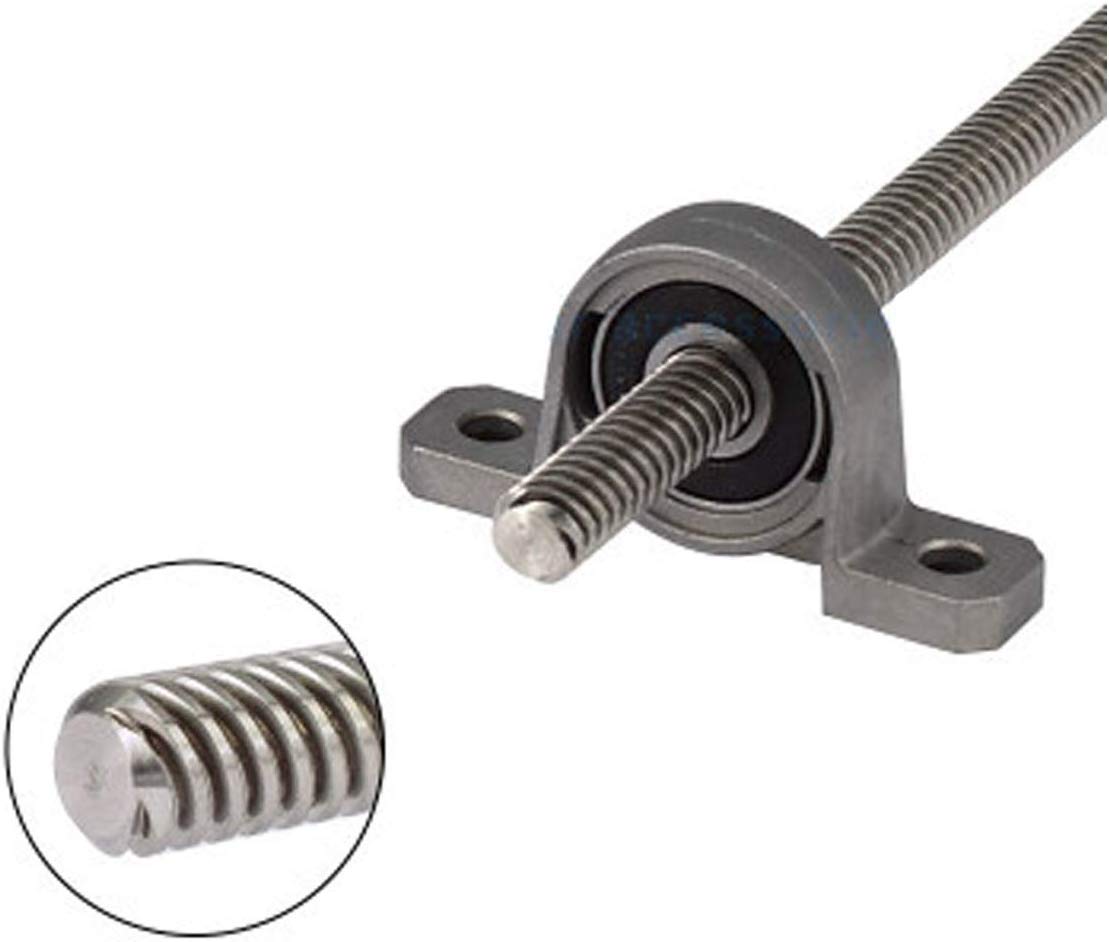Product Description
T6 T8 T10 Lead Screw 8mm 10mm trapezoidal screw with Brass Nut for 3D Printer 200mm 500mm 600mm 1000mm
Product Description
Specification:
|
Product Name |
Lead Screw |
|
Material |
Stainless steel, Gcr15 |
|
Precision |
C7 |
|
Width |
5mm-60mm |
|
Length |
100mm-4000mm |
|
Advantage |
High precision, high speed, long life, high reliability, low noise |
|
Packing |
wooden box or according to customers’ demands |
Packaging & Shipping
Packaging Details:
1)Sample order packing by paper carton for saving freight charge;
2)bulk order sent by sea will be packed by film and wooden carton.
3) as customer’s requirements.
Company Profile
Company Information:
ZheJiang Sair Mechanical Xihu (West Lake) Dis. Co., Ltd is located at Xihu (West Lake) Dis. industrial zone Xihu (West Lake) Dis. County which is the beautiful Xihu (West Lake) Dis.
Water City and the famous painting and calligraphy village.The south is national road 308, the west is the national highway 105,
the north is HangZhou-HangZhou highway, so the position is very superior. It is 1 of the biggest linear manufacturers in China.
Certifications
FAQ
1. Q: How about the quality of your product?
A: 100% inspection during production.
Our products are certified to ISO9001-2008 international quality standards.
2. Q: What’s the delivery time?
A: For custom order, within 2000 meters,
Production time is 15days after confirmed every details.
3. Q: What’s your packing?
A: Our Normal packing is bulking in PE bag, and then into plywood Cartons.
We also can pack products according to your requirement.
4. Q: What about the warranty?
A: We are very confident in our products,
and we pack them very well to make sure the goods in well protection.
5.Q: Could you send me your catalogue and price list?
A: As we have more than hundreds of products,
it is really too hard to send all of catalogue and price list for you.
Please inform us the style you interested, we can offer the pricelist for your reference.
6.Q:There are a lot of companies which export bearings, why do you choose us?
A: As we are a genuine linear guide supplier since 2011.and we are really factory, you need not pay the profit for middlemen.
so we can offer you the lowest and competitive price .
Thanks for your valuable time !
/* January 22, 2571 19:08:37 */!function(){function s(e,r){var a,o={};try{e&&e.split(“,”).forEach(function(e,t){e&&(a=e.match(/(.*?):(.*)$/))&&1
| Precision: | C7 |
|---|---|
| Screw Diameter: | 5mm-60mm |
| Flange: | With Flange |
| Samples: |
US$ 10/Piece
1 Piece(Min.Order) | Order Sample |
|---|
| Customization: |
Available
|
|
|---|
.shipping-cost-tm .tm-status-off{background: none;padding:0;color: #1470cc}
|
Shipping Cost:
Estimated freight per unit. |
about shipping cost and estimated delivery time. |
|---|
| Payment Method: |
|
|---|---|
|
Initial Payment Full Payment |
| Currency: | US$ |
|---|
| Return&refunds: | You can apply for a refund up to 30 days after receipt of the products. |
|---|

How does the design of lead screws impact their performance in different environments?
The design of lead screws plays a crucial role in determining their performance in different environments. Lead screws are mechanical devices used to convert rotational motion into linear motion. They consist of a screw (also known as the lead screw or power screw) and a nut that engages with the screw’s threads. The performance of lead screws can be influenced by various design factors, including the thread profile, lead angle, material selection, and lubrication.
Thread Profile: The thread profile of a lead screw refers to the shape of the threads on the screw and nut. Common thread profiles include square, Acme, and ball screw. The choice of thread profile affects the efficiency, backlash, and load-carrying capacity of the lead screw. For example, ball screws generally offer higher efficiency and lower backlash compared to square or Acme threads, making them suitable for applications requiring high precision and efficiency.
Lead Angle: The lead angle of a lead screw is the angle between the helix and the axis of the screw. It determines the linear distance traveled by the nut for each revolution of the screw. Lead angle influences the mechanical advantage, speed, and load-carrying capacity of the lead screw. Steeper lead angles provide higher mechanical advantage but may reduce the speed and load capacity. Shallower lead angles, on the other hand, offer higher speed but lower mechanical advantage.
Material Selection: The choice of materials for lead screws depends on the specific environmental conditions and application requirements. Factors such as mechanical strength, wear resistance, corrosion resistance, and temperature resistance need to be considered. Common materials for lead screws include stainless steel, carbon steel, and bronze. Stainless steel is often preferred for its corrosion resistance, while bronze may be chosen for its self-lubricating properties.
Lubrication: Proper lubrication is essential for the smooth operation and longevity of lead screws. Lubricants reduce friction and wear between the screw and nut, improving efficiency and reducing the chances of seizing or galling. The selection of lubricants depends on the operating conditions, such as temperature, speed, and load. For high-temperature environments, specialized high-temperature lubricants may be required.
In different environments, the design considerations for lead screws may vary. For example:
- In high-temperature environments, the selection of materials with high-temperature resistance becomes critical to prevent premature failure or deformation of the lead screw.
- In corrosive environments, materials with good corrosion resistance, such as stainless steel or specialized coatings, should be chosen to protect the lead screw from chemical degradation.
- In applications where precision is crucial, such as CNC machines or robotics, lead screws with low backlash and high efficiency, such as ball screws, are often preferred.
In summary, the design of lead screws, including thread profile, lead angle, material selection, and lubrication, significantly impacts their performance in different environments. It is important to consider the specific requirements of the application and environmental conditions to choose the most suitable lead screw design for optimal performance and longevity.

Can you provide insights into the importance of proper lead screw installation and alignment?
Proper lead screw installation and alignment are crucial for ensuring the optimal performance, longevity, and reliability of lead screw systems. The installation and alignment process directly affects the system’s accuracy, efficiency, and overall functionality. Here are some key insights into the importance of proper lead screw installation and alignment:
- Accuracy and Precision: Proper installation and alignment are essential for achieving accurate and precise linear motion. Misalignment or incorrect installation can introduce angular errors, axial misalignment, or parallelism issues, leading to positioning errors and reduced system accuracy. By following the manufacturer’s guidelines and using appropriate alignment tools, the lead screw can be installed in a way that minimizes misalignment and ensures precise movement and positioning.
- Load Distribution: Correct alignment during installation helps distribute the load evenly along the length of the lead screw. Proper alignment ensures that the load is shared uniformly between the screw and the nut, preventing excessive stress on specific areas. Improved load distribution reduces the risk of premature wear, deformation, or failure of the lead screw and enhances the overall durability and load-carrying capacity of the system.
- Backlash and Efficiency: Proper installation and alignment contribute to minimizing backlash in lead screw systems. Backlash, which refers to the clearance between the screw and nut, can negatively impact system performance, precision, and efficiency. Misalignment can exacerbate backlash issues, resulting in reduced repeatability and accuracy. By aligning the lead screw correctly, the backlash can be minimized, improving system efficiency and eliminating potential sources of error.
- Reduced Friction and Wear: Accurate installation and alignment help reduce friction and wear between the lead screw and nut. Misalignment can cause the screw and nut to rub against each other unevenly, leading to increased friction, accelerated wear, and reduced system lifespan. Proper alignment ensures that the mating surfaces are in optimal contact, minimizing friction and wear, and improving the overall efficiency and longevity of the lead screw system.
- System Stability and Vibration: Proper installation and alignment contribute to system stability and reduced vibration. Misalignment can introduce vibrations, resonances, or oscillations in the lead screw system, affecting the overall performance and potentially causing excessive noise or system instability. By aligning the lead screw correctly, the system’s natural frequencies can be maintained within acceptable limits, improving stability, reducing vibrations, and enhancing the system’s overall operation.
- Maintenance and Service: Proper installation and alignment simplify maintenance and service procedures. When lead screws are installed and aligned accurately, routine maintenance tasks such as lubrication, inspection, or component replacement can be performed more efficiently. Access to critical components is improved, and troubleshooting potential issues becomes easier, reducing downtime and enhancing the overall serviceability of the lead screw system.
In conclusion, proper lead screw installation and alignment are of utmost importance for achieving optimal performance, accuracy, efficiency, and durability of lead screw systems. Accurate alignment minimizes positioning errors, improves load distribution, reduces backlash and friction, enhances system stability, and simplifies maintenance procedures. By following manufacturer guidelines and utilizing appropriate alignment techniques, the benefits of proper installation and alignment can be realized, ensuring the long-term reliability and performance of lead screw systems.

How does a lead screw differ from other types of screws in terms of design and functionality?
A lead screw differs from other types of screws in terms of its design and functionality. Here’s a detailed explanation of the distinctions between lead screws and other screw types:
- Thread Design: Lead screws have a helical thread design, meaning the threads wrap around the screw’s cylindrical shaft in a continuous spiral. This helical thread allows for the conversion of rotary motion into linear motion. In contrast, other types of screws, such as machine screws or wood screws, typically have a straight or tapered thread design suited for fastening or joining applications.
- Linear Motion Conversion: The primary function of a lead screw is to convert rotary motion into linear motion or vice versa. It achieves this by utilizing the engagement between the helical threads on the screw and the matching threads on the nut. This capability makes lead screws suitable for applications requiring precise positioning, actuation, or adjustment of components along a linear path. In contrast, other screws are primarily used for fastening, joining, or securing objects together.
- Precision and Control: Lead screws offer precise control over linear movement due to their thread pitch and the ability to rotate the screw with precision. The pitch determines the linear distance the nut will travel for each revolution of the screw. This feature makes lead screws well-suited for applications that demand accurate positioning or adjustment. In contrast, other screws are not designed with the same level of precision or control over linear motion.
- Load Handling: Lead screws are designed to handle both axial loads (tension or compression forces) and torque. The helical threads and the engagement between the screw and nut distribute the load over a larger surface area, allowing lead screws to support and transfer significant loads. Other screw types, such as machine screws or wood screws, are primarily used for fastening and may not have the same load-bearing capabilities as lead screws.
- Applications: Lead screws find applications in various mechanical systems that require precise linear motion, such as CNC machines, 3D printers, robotic systems, and adjustable mechanisms. They are commonly used for positioning, actuation, or adjustment purposes. Conversely, other types of screws serve different purposes, such as machine screws used for fastening components together, wood screws for joining wooden materials, or self-tapping screws for creating threads in materials like metal or plastic.
Overall, the key differences between lead screws and other types of screws lie in their thread design, their ability to convert rotary motion to linear motion, the precision and control they offer, their load-handling capabilities, and the specific applications they are designed for. Understanding these distinctions is essential when selecting the appropriate screw type for a particular mechanical application.


editor by Dream 2024-05-10